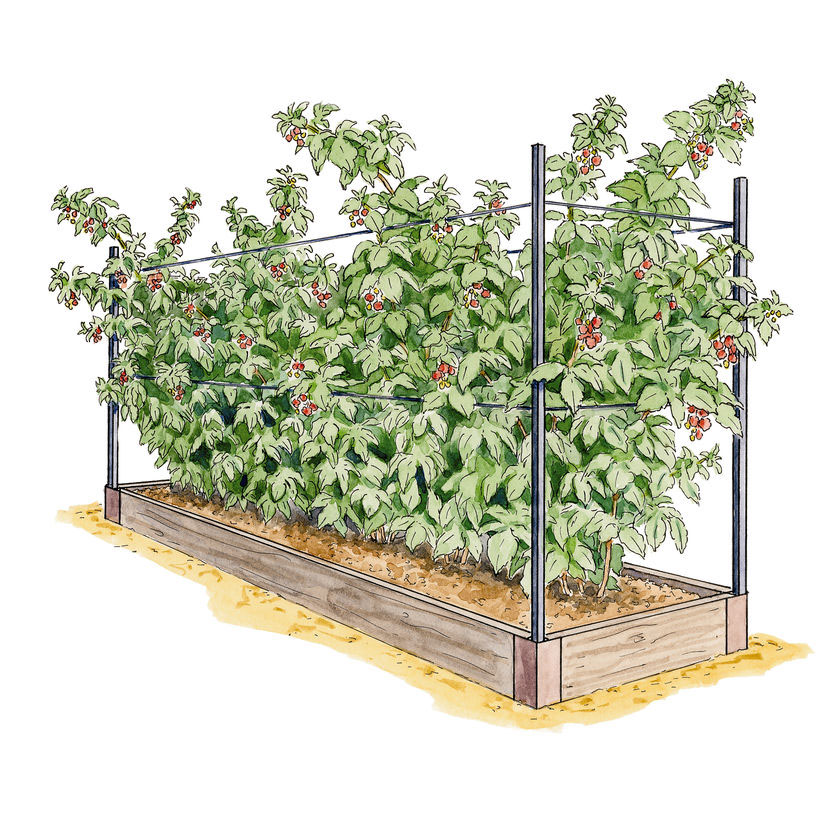No products
 View larger
View larger
Growing Raspberries
Nik Magnus | © 2019 Woodbridge Fruit Trees | www.woodbridgefruittrees.com.au
Raspberries are grouped into Summer and Autumn fruiting varieties. They are best planted as bare rooted dormant canes in winter months. They prefer loose well drained fertile soil and dont tolerate waterlogging. Often one or two canes dont wake up, but after a few years, they will sucker up
Planting: Plant in loose well drained soil, 30-60cm apart with plenty of organic matter. Water in well. Prune to 20-30cm to encourage basal shooting. Its not uncommon to lose 1 or 2 canes. After a couple of years, suckers can be transplanted to fill in any gaps that occurred.
Trellis: Raspberries are self supportive, but a simple perimeter allows a few wires to be strung on either side of the raspberry bed to prevent them from flopping over. Also a T bracket on either side with a wire attached to the arms allows a net to be draped over them protecting them from birds.

Pruning: Pruning is done in winter when dormant. This is made easier when you remember that autumn ripening raspberries grow on the new seasons growth, while the summer ripening varieties form fruit on the previous years growth. The older canes can be easily told apart from the new canes, as they are woodier and less flexible and often brown rather than green and soft.
AUTUMN FRUITING VARIETIES: Prune all except the smallest canes.
SUMMER FRUITING VARIETIES: Prune back the older canes leaving last years new growth. These are browner and thicker than the younger canes which are softer and greener. Next seasons fruit will form on these younger canes the following summer.
Raspberries like to be mulched and watered well in summer. The do not like wet winters where there is poor drainage as they tend to rot.
This product is no longer in stock
Nik Magnus | © 2019 Woodbridge Fruit Trees | www.woodbridgefruittrees.com.au
Raspberries are grouped into Summer and Autumn fruiting varieties. They are best planted as bare rooted dormant canes in winter months. They prefer loose well drained fertile soil and dont tolerate waterlogging. Often one or two canes dont wake up, but after a few years, they will sucker up
Planting: Plant in loose well drained soil, 30-60cm apart with plenty of organic matter. Water in well. Prune to 20-30cm to encourage basal shooting. Its not uncommon to lose 1 or 2 canes. After a couple of years, suckers can be transplanted to fill in any gaps that occurred.
Trellis: Raspberries are self supportive, but a simple perimeter allows a few wires to be strung on either side of the raspberry bed to prevent them from flopping over. Also a T bracket on either side with a wire attached to the arms allows a net to be draped over them protecting them from birds.

Pruning: Pruning is done in winter when dormant. This is made easier when you remember that autumn ripening raspberries grow on the new seasons growth, while the summer ripening varieties form fruit on the previous years growth. The older canes can be easily told apart from the new canes, as they are woodier and less flexible and often brown rather than green and soft.
AUTUMN FRUITING VARIETIES: Prune all except the smallest canes.
SUMMER FRUITING VARIETIES: Prune back the older canes leaving last years new growth. These are browner and thicker than the younger canes which are softer and greener. Next seasons fruit will form on these younger canes the following summer.
Raspberries like to be mulched and watered well in summer. The do not like wet winters where there is poor drainage as they tend to rot.
Reviews
No customer reviews for the moment.

